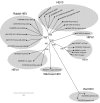Hepatitis E virus strains in rabbits and evidence of a closely related strain in humans, France
- PMID: 22840216
- PMCID: PMC3414036
- DOI: 10.3201/eid1808.120057
Hepatitis E virus strains in rabbits and evidence of a closely related strain in humans, France
Abstract
Hepatitis E virus (HEV) strains from rabbits indicate that these mammals may be a reservoir for HEVs that cause infection in humans. To determine HEV prevalence in rabbits and the strains' genetic characteristics, we tested bile, liver, and additional samples from farmed and wild rabbits in France. We detected HEV RNA in 7% (14/200) of bile samples from farmed rabbits (in 2009) and in 23% (47/205) of liver samples from wild rabbits (in 2007-2010). Full-length genomic sequences indicated that all rabbit strains belonged to the same clade (nucleotide sequences 72.2%-78.2% identical to HEV genotypes 1-4). Comparison with HEV sequences of human strains and reference sequences identified a human strain closely related to rabbit strain HEV. We found a 93-nt insertion in the X domain of open reading frame 1 of the human strain and all rabbit HEV strains. These findings indicate that the host range of HEV in Europe is expanding and that zoonotic transmission of HEV from rabbits is possible.
Figures


References
MeSH terms
Substances
Associated data
- Actions
- Actions
- Actions
- Actions
- Actions
- Actions
- Actions
LinkOut - more resources
Full Text Sources
Other Literature Sources
Medical
Research Materials
